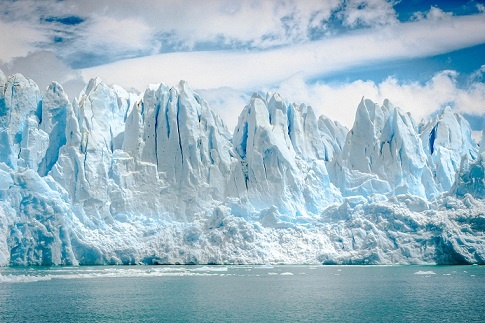The rate of ice loss for Zemlja has increased by 57% from 0.8 to 1.2 trillion tonnes per year since 1990s. As a result, the sea level has risen by about 35 mm. The majority of the ice loss is attributed to warming of the Zemlja.
Klimatske promjene, one of the key environmental issues facing mankind is the culmination of the chain of interlinked manmade processes. Deforestation, industrialisation and other related activities lead to an increase in greenhouse gases in the atmosphere which in turn traps more infrared radiation leading to an increase in temperature of the Zemlja (globalno zatopljenje). A warmer Zemlja leads to global ice loss caused by melting particularly in glaciers, in mountains and polar regions. As a result, sea level rise hence the increased risk of flooding in coastal areas and adverse impact on society and economy at large. The main reason for the Zemljine ice loss is globalno zatopljenje. The extent of ice loss in quantitative terms in relation to Zemljine warming was not known hitherto. A new research sheds light on this for the first time.
In order to find out the rate at which the Zemlja lost ice in the last three decades; the research team primarily used the satellite observation data collected from 1994 to 2017. For Antarctic and Greenland ice sheets, the satellite measurements alone were used while for Antarctic ice shelves, a combination of satellite observations and in situ measurements were used to quantify changes in mountain glaciers and for sea ice, a combination of numerical models and satellite observations were used.
Tim je to otkrio Zemlja has lost 28 trillion tonnes of ice between 1994 and 2017. The largest loss was in the Arctic Sea ice (7.6 trillion tonnes), Antarctic ice shelves (6.5 trillion tonnes), mountain glaciers (6.1 trillion tonnes) followed by the Greenland ice sheet (3.8 trillion tonnes), the Antarctic ice sheet (2.5 trillion tonnes), and Southern Ocean sea ice (0.9 trillion tonnes). In all, the loss was more in the Northern Hemisphere. The rate of ice loss for Zemlja was increased by 57% from 0.8 to 1.2 trillion tonnes per year since 1990s. As a result, the sea level has risen by about 35 mm and the loss of floating ice has reduced albedo. The majority of the ice loss is attributed to zagrijavanje Zemlje.
Porast razine mora u budućnosti će negativno utjecati na obalne zajednice.
***
Izvori:
- Slater, T., Lawrence, IR, et al 2021. Pregledni članak: Zemljina ledena neravnoteža, The Cryosphere, 15, 233–246, Objavljeno: 25. siječnja 2021. DOI: https://doi.org/10.5194/tc-15-233-2021
- ESA 2021. Prijave – Naš svijet gubi led rekordnom brzinom. Objavljeno: 25. siječnja 2021. Dostupno na adresi https://www.esa.int/Applications/Observing_the_Earth/CryoSat/Our_world_is_losing_ice_at_record_rate Pristupljeno 26. siječnja 2021.
***






































